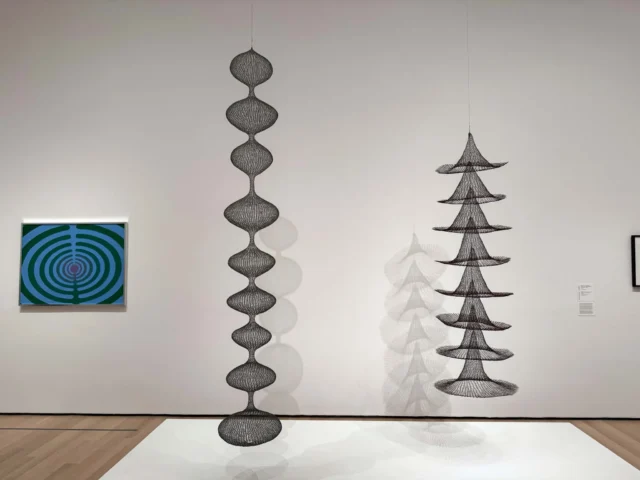
19 Nov TIO NYC: Ruth Asawa at MOMA & “The Honey Trap” at Irish Rep!
If art imitate life, these two shows, one in a museum, the other on the boards, are two strong cases in point.

Installation view, courtesy Hyperallergic.
With the Museum of Modern Art’s (MOMA) epic tribute, “Ruth Asawa: Through Line,” the artist, long relegated to the margins of 20th-century art history, emerges as a innovator and visionary.
“I’m not so interested in the expression of something. I’m more interested in what the material can do. So that’s why I keep exploring.”
This mind-blowing, eye-dazzler of a show is quietly radical. Asawa’s wire art rewires our sense of what art can be: quiet and transcendent; domestic and cosmic; grounded and infinite. Her looped-wire sculptures — weightless, floating cocoons — emerge as both architectural and ethereal, tangible and transparent.
Standing before them, it. is tough to believe they were made by a human hand. The works are like line drawings set loose into the air: geometry animated by breath, a thing David Smith achieved in his work too. (Smith’s welded steel sculptures were often described as “drawings in space.”)
Born in California to Japanese immigrants, imprisoned in a WWII internment camp, educated at Black Mountain College under Josef Albers and Buckminster Fuller, Asawa turned adversity into artistry. Her resilience, insatiable curiosity and intellect shaped a career that blurred boundaries between art, craft, education, and life. Her San Francisco home doubled as a workshop and classroom; her sculptures hung over kitchen tables as easily as museum ceilings.

courtesy Hyperallergic

courtesy Hyperallergic

courtesy, Hyperallergic
As for those sculptures, what looks delicate from afar turns, up close, into a feat of engineering and grace so precise it borders on sorcery. This is not just a show — it’s an experience, a meditation on space, light, and form by an artist who could make air itself appear sculpted.
Thankfully MoMA’s curators wisely resisted pigeonholing Asawa as “that wire lady.” Instead, they open up her body of work: drawings, prints, masks, public art, even school projects — all evidence of a restless mind for whom art was life and life was art.
Light was clearly Asawa’s silent partner, her collaborator. Her suspended forms throw shadows across the walls and floors — ghost doubles, as alive as their solid counterparts, those wire pieces. Move just an inch, and the whole work shifts: inside becomes outside, negative space comes alive. This optical symphony teaches us how to look at art — patiently, attentively and, finally, humbly.
And that’s perhaps Asawa’s deep magic: somehow she managed to transform craft into contemplation. Wire, the most utilitarian of materials, becomes a conduit for awe. There’s nothing flashy about Asanas method, but the results completely seduce.
If you can only see one exhibition this season, make it this one. You will leave a bit dazed, your sense of space — and maybe of possibility when art and life merge — permanently altered.
“Ruth Asawa: Through Line” is as much revelation as retrospective.
Read this terrific review in ArtNet.
“The Honey Trap”
After a completely sold-out New York premiere, “The Honey Trap” returns by popular demand for a final run, January 10 – February 15, 2026, on the Francis J. Greenburger Mainstage, according to the Irish Rep.

Sensitively, meticulously directed by Matt Torney,”The Honey Trap” is compelling theatre that offers more than just a retelling of historical events in the time of The Troubles in Belfast in the 1970s. It is a taut, disquieting psychological thriller that explores the nexus of memory, guilt, identity and the way the past informs the present.
The staging of the show at Irish Rep is brilliantly conceived and executed: the performances –especially that of Mike Hayden as the anti-hero Dave – carry the weight of the story. The technical design supports the emotional tension, which reaches a boil, while blurring the line between past and present. The production postulates that time can be circular.
The plot follows two off-duty British soldiers who pick up two local women at a Unionist pub – then one of them ends up dead. Decades later, a researcher interviews the surviving soldier, Dave, to uncover what went down.
And so the action unfolds.
Caveat emptor: “The Honey Trap” is not easy theater. The protagonist is flawed in ways that challenge sympathy. For one thing he is a manipulative bully. And the emotional payoff isn’t neat. It is messy, much like history. And real life.
“It’s a play that lingers like guilt itself—uncomfortable, inescapable, and impossible to resolve,” said Show Score.
But if you are a theatre-goer who is drawn to morally complex characters, challenging stories about the lasting effects of conflict and plays that refuse to let you go after the curtain then goes down, then GO!.
“The Honey Trap” is not just a show — it is an experience you may not want to miss.
“A THRILLER that keeps audiences RAPT until the end.TAUT, SUSPENSEFUL STORYTELLING…and dabbles in deception until the very last line…, Laura Collins-Hughes, The New York Times.


No Comments